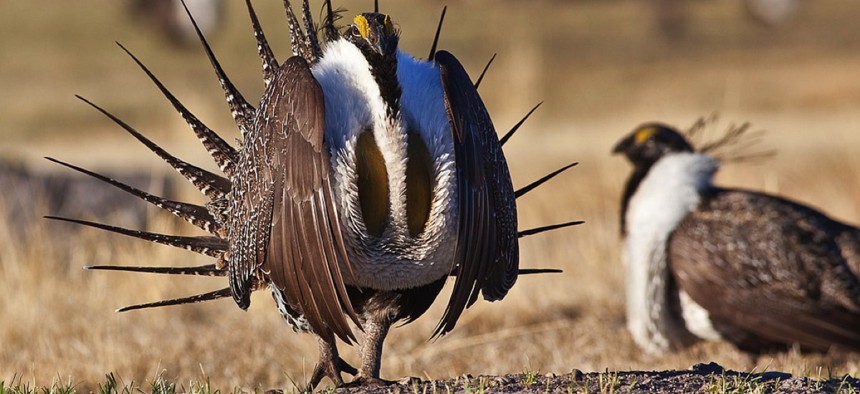Trump’s Federal Land-Use Regulatory Battle Targets Obama’s Sage Grouse Rules

Greater Sage Grouse Bureau of Land Management
“They might as well form a shotgun posse to kill off the species directly,” according to a Center for Biological Diversity activist.
U.S. Interior Secretary Ryan Zinke on Wednesday ordered a 60-day federal review of greater sage grouse conservation efforts in 11 Western states, arguing protection needn’t “impede local economic opportunities.”
In September 2015, the Obama administration finalized a plan to keep the sage grouse off the endangered species list that revised 98 Bureau of Land Management and U.S. Forest Service land-use plans.
As with President Trump’s rollback of other environmental safeguards, namely the Paris climate accord and Clean Air Act, the White House hammered the plan’s threat to economic development.
“While the federal government has a responsibility under the Endangered Species Act to responsibly manage wildlife, destroying local communities and levying onerous regulations on the public lands that they rely on is no way to be a good neighbor," Zinke said in the announcement. "State agencies are at the forefront of efforts to maintain healthy fish and wildlife populations, and we need to make sure they are being heard on this issue.”
“As we move forward with implementation of our strategy for sage-grouse conservation, we want to make sure that we do so first and foremost in consultation with state and local governments, and in a manner that allows both wildlife and local economies to thrive,” he continued.
Ironically, Zinke also called on BLM, the U.S. Fish and Wildlife Service, and U.S. Geological Survey to focus on addressing the two biggest threats to rangeland health and sage grouse habitat: invasive grasses and wildfires—the latter exacerbated by the climate change the president has said he doubts.
Zinke also threw out the possibility of captive breeding programs, state population target setting and boosting state involvement in sage grouse conservation—likely reducing federal involvement—so more of the bird’s habitat can be developed.
Colorado Gov. John Hickenlooper, a Democrat, and Wyoming Gov. Matt Mead, a Republican, have argued a habitat-management model is more effective than setting state population objectives.
“By issuing this review, the Interior Department is ignoring the input of local stakeholders who spent years working to avoid a damaging Endangered Species Act listing and find a path forward for sage grouse habitat management,” U.S. Sen. Ron Wyden, an Oregon Democrat, said in a statement. “When it comes to managing the traditional multiple uses of our public lands, the Interior Department must ensure that all local stakeholders have a seat at the table, not just those who agree with this administration’s goals of benefitting the oil and gas industry.”
The more than $750 million Obama administration plan has been criticized by environmentalists for its loopholes that spell the sage grouse’s extinction, as well as miners, ranchers and Republican officials in Utah, Idaho and Nevada who favor oil and gas drilling on the land.
Jim Lyons, a former Obama administration official who helped develop the plan, told the Billings Gazette the review was "a thinly-veiled and unnecessary attempt to open up important habitat to oil and gas drilling, jeopardizing the important balance and flexibility offered in the existing plans."
The sage grouse population once reached 16 million birds, but there are now only about 200,000 to 500,000 nationwide.
“Zinke’s ‘review’ is clearly a pretext to push the sage grouse to extinction in return for short-term profits for his corporate buddies,” Randi Spivak, the Center for Biological Diversity’s public lands program director, said in a statement. “They might as well form a shotgun posse to kill off the species directly.”
Dave Nyczepir is a News Editor at Government Executive’s Route Fifty and is based in Washington, D.C.
NEXT STORY: Indiana County Returns Artifacts Taken From Tribal Graves






